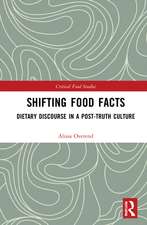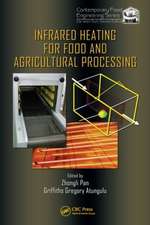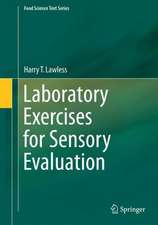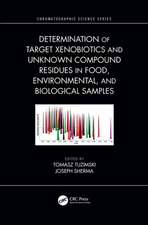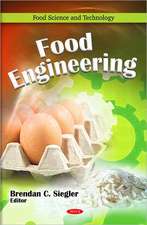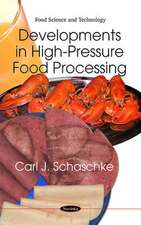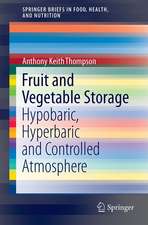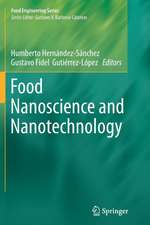Sensory Evaluation of Food: Principles and Practices: Food Science Text Series
Autor Harry T. Lawless, Hildegarde Heymannen Limba Engleză Paperback – 23 aug 2016
| Toate formatele și edițiile | Preț | Express |
|---|---|---|
| Paperback (1) | 472.29 lei 38-44 zile | |
| Springer – 23 aug 2016 | 472.29 lei 38-44 zile | |
| Hardback (1) | 469.18 lei 3-5 săpt. | +57.27 lei 10-14 zile |
| Springer – 14 sep 2010 | 469.18 lei 3-5 săpt. | +57.27 lei 10-14 zile |
Din seria Food Science Text Series
- 17%
 Preț: 502.95 lei
Preț: 502.95 lei - 17%
 Preț: 469.18 lei
Preț: 469.18 lei - 15%
 Preț: 549.39 lei
Preț: 549.39 lei - 20%
 Preț: 579.80 lei
Preț: 579.80 lei -
 Preț: 458.78 lei
Preț: 458.78 lei - 15%
 Preț: 566.10 lei
Preț: 566.10 lei - 13%
 Preț: 358.75 lei
Preț: 358.75 lei - 15%
 Preț: 635.75 lei
Preț: 635.75 lei -
 Preț: 396.40 lei
Preț: 396.40 lei -
 Preț: 482.23 lei
Preț: 482.23 lei -
 Preț: 392.37 lei
Preț: 392.37 lei -
 Preț: 398.35 lei
Preț: 398.35 lei - 15%
 Preț: 508.60 lei
Preț: 508.60 lei - 15%
 Preț: 508.75 lei
Preț: 508.75 lei - 15%
 Preț: 587.39 lei
Preț: 587.39 lei - 18%
 Preț: 965.83 lei
Preț: 965.83 lei -
 Preț: 393.13 lei
Preț: 393.13 lei - 15%
 Preț: 532.70 lei
Preț: 532.70 lei - 15%
 Preț: 593.26 lei
Preț: 593.26 lei -
 Preț: 474.31 lei
Preț: 474.31 lei - 15%
 Preț: 658.05 lei
Preț: 658.05 lei - 15%
 Preț: 600.74 lei
Preț: 600.74 lei - 18%
 Preț: 971.22 lei
Preț: 971.22 lei - 15%
 Preț: 477.74 lei
Preț: 477.74 lei - 18%
 Preț: 1010.33 lei
Preț: 1010.33 lei - 15%
 Preț: 477.74 lei
Preț: 477.74 lei - 15%
 Preț: 574.25 lei
Preț: 574.25 lei
Preț: 472.29 lei
Nou
Puncte Express: 708
Preț estimativ în valută:
90.37€ • 94.61$ • 74.78£
90.37€ • 94.61$ • 74.78£
Carte tipărită la comandă
Livrare economică 01-07 aprilie
Preluare comenzi: 021 569.72.76
Specificații
ISBN-13: 9781493950393
ISBN-10: 1493950398
Pagini: 596
Ilustrații: XXIII, 596 p.
Dimensiuni: 193 x 260 x 39 mm
Greutate: 1.28 kg
Ediția:Softcover reprint of the original 2nd ed. 2010
Editura: Springer
Colecția Springer
Seria Food Science Text Series
Locul publicării:New York, NY, United States
ISBN-10: 1493950398
Pagini: 596
Ilustrații: XXIII, 596 p.
Dimensiuni: 193 x 260 x 39 mm
Greutate: 1.28 kg
Ediția:Softcover reprint of the original 2nd ed. 2010
Editura: Springer
Colecția Springer
Seria Food Science Text Series
Locul publicării:New York, NY, United States
Cuprins
Physiological and Psychological Foundations of Sensory Function.- Principles of Good Practice.- Discrimination Testing.- Similarity, Equivalence Testing, and Discrimination Theory.- Measurement of Sensory Thresholds.- Scaling.- Time–Intensity Methods.- Context Effects and Biases in Sensory Judgment.- Descriptive Analysis.- Texture Evaluation.- Color and Appearance.- Preference Testing.- Acceptance Testing.- Consumer Field Tests and Questionnaire Design.- Qualitative Consumer Research Methods.- Quality Control and Shelf-Life (Stability) Testing.- Data Relationships and Multivariate Applications.- Strategic Research.- Erratum to: Similarity, Equivalence Testing, and Discrimination Theory.
Recenzii
From the reviews of the second edition:
“This volume is an academic text, bringing together theory, methodologies and analysis techniques of sensory evaluation and references to thousands of research articles on sensory science in a logical and practical manner. … its primary aim is as a textbook for university-level sensory science modules. … also serves as an over-arching technical manual and resource for practicing food and drink technologists and sensory scientists. … The book is essential reading for those in the sensory evaluation sphere and serves as an excellent and practical reference.” (Patricia Stefanowicz, Journal of Wine Research, Vol. 24 (1), 2013)
“This volume is an academic text, bringing together theory, methodologies and analysis techniques of sensory evaluation and references to thousands of research articles on sensory science in a logical and practical manner. … its primary aim is as a textbook for university-level sensory science modules. … also serves as an over-arching technical manual and resource for practicing food and drink technologists and sensory scientists. … The book is essential reading for those in the sensory evaluation sphere and serves as an excellent and practical reference.” (Patricia Stefanowicz, Journal of Wine Research, Vol. 24 (1), 2013)
Notă biografică
Harry T. Lawless is Professor of Food Science at Cornell University where he teaches sensory evaluation. He has 35 years of experience in chemosensory research and psychophysics. He spent five years in consumer testing in industry, and serves as a consultant to various food and consumer products companies on sensory test methods. Hildegarde Heymann is Professor of Viticulture and Enology at the University of California at Davis where she teaches sensory evaluation of wine and sensometrics. She spent nearly 17 years at the University of Missouri as a professor of sensory science.
Textul de pe ultima copertă
The field of sensory science has grown exponentially since the publication of the first edition of Sensory Evaluation of Food. Fifteen years ago, the journal Food Quality and Preference was fairly new. Now it holds an eminent position as a venue for research on sensory test methods (among many other topics). Knowledge of the intricate cellular processes in chemoreception, as well as their genetic basis has undergone nothing less than a revolution, culminating in the award of the Nobel Prize to Buck and Axel in 2004 for their discovery of the olfactory receptor gene super family. Advances in statistical methodology have accelerated as well. Sensometrics meetings are now vigorous and well-attended annual events. And yet, some things stay the same. Sensory testing will always involve human participants. But humans are tough measuring instruments to work with. They come with varying degrees of acumen, training, experiences, differing genetic equipment, sensory capabilities, and of course, different preferences. Human foibles and their associated error variance will continue to place a limitation on sensory tests and actionable results.
Although methods continue to evolve, appreciation of the core principles of the field is the key to effective application of sensory test methods. This book has been expanded to reflect the advances in methodologies, theory, and analysis that have transpired in the last 15 years. The chapters are now divided into numbered subsections. This may be of assistance to educators who may wish to assign only certain critical sections to beginning students. In some of the opening sections instructors will find suggestions about which sections are key for fundamental understanding of that topic or method. In many chapters we have gone out on a limb and specified a “recommended procedure.” In cases where there are multiple options for procedure or analysis, we usually chose a simple solution over one that is more complex.
This text attempts to be comprehensive, yet understandable to all students at the university level. All the major sensory test methods are illustrated and discussed, including discrimination, descriptive, and affective tests. Some chapters are devoted to special topics, such as thresholds, time-intensity methods, similarity testing, color, texture, sensory quality control, qualitative research methods, consumer test methods and questionnaires, shelf life testing, an introduction to multivariate statistical techniques, and strategic sensory research. The statistical appendix provides basic instruction in the common statistical analyses for sensory evaluation with worked examples.
Harry T. Lawless is Professor of Food Science at Cornell University where he teaches sensory evaluation. He has 35 years of experience in chemosensory research and psychophysics. He spent five years in consumer testing in industry, and serves as a consultant to various food and consumer products companies on sensory test methods.
Hildegarde Heymann is Professor of Viticulture and Enology at the University of California at Davis where she teaches sensory evaluation of wine and sensometrics. She spent nearly 17 years at the University of Missouri as a professor of sensory science.
Although methods continue to evolve, appreciation of the core principles of the field is the key to effective application of sensory test methods. This book has been expanded to reflect the advances in methodologies, theory, and analysis that have transpired in the last 15 years. The chapters are now divided into numbered subsections. This may be of assistance to educators who may wish to assign only certain critical sections to beginning students. In some of the opening sections instructors will find suggestions about which sections are key for fundamental understanding of that topic or method. In many chapters we have gone out on a limb and specified a “recommended procedure.” In cases where there are multiple options for procedure or analysis, we usually chose a simple solution over one that is more complex.
This text attempts to be comprehensive, yet understandable to all students at the university level. All the major sensory test methods are illustrated and discussed, including discrimination, descriptive, and affective tests. Some chapters are devoted to special topics, such as thresholds, time-intensity methods, similarity testing, color, texture, sensory quality control, qualitative research methods, consumer test methods and questionnaires, shelf life testing, an introduction to multivariate statistical techniques, and strategic sensory research. The statistical appendix provides basic instruction in the common statistical analyses for sensory evaluation with worked examples.
Harry T. Lawless is Professor of Food Science at Cornell University where he teaches sensory evaluation. He has 35 years of experience in chemosensory research and psychophysics. He spent five years in consumer testing in industry, and serves as a consultant to various food and consumer products companies on sensory test methods.
Hildegarde Heymann is Professor of Viticulture and Enology at the University of California at Davis where she teaches sensory evaluation of wine and sensometrics. She spent nearly 17 years at the University of Missouri as a professor of sensory science.
Caracteristici
The first volume of this book, which has not been updated since 1998, still remains a classroom and research favorite. Sensory evaluation is a required class for any Food Science undergraduate major, and this has served for nearly a decade as one of the only texts. Comprehensive in scholarship and represents divergent philosophies in the field in a balanced manner Includes supplementary material: sn.pub/extras








